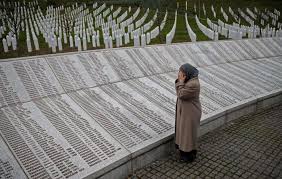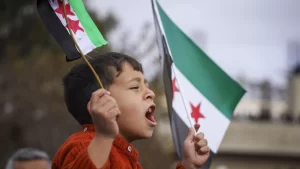
Thirty years after the Srebrenica genocide. The victims’ legal odyssey
Thirty years after the Srebrenica genocide. The victims’ legal odyssey Written for the componente: Armed conflicts Thirty years after
Written for the componente: Armed conflicts

Thirty years after the Srebrenica genocide. The victims’ legal odyssey
The 1995 Srebrenica massacre, perpetrated by Serbs against Muslims, was defined as a genocide by the International Criminal Tribunal for the former Yugoslavia. It was one of the most serious massacres since World War II, documented both in the trial proceedings that convicted General Mladić and his subordinates, and in the reconstructions of historians, such as Jože Pirjevec in “The Yugoslav Wars.”
The Srebrenica enclave was attacked on July 6, 1995, but the actual genocide took place between July 11 and 22. The UN mission, UNPROFOR, was powerless, and the Dutch peacekeepers were forced to surrender and hand over their weapons to Mladić’s Serbs, including the infamous “Arkan’s Tigers.”
Five hundred tanks entered the city, while terrified refugees gathered around the UN peacekeepers’ positions. The population was abandoned, while eighteen NATO planes flew over the Serb positions only on the afternoon of the 11th, in a largely demonstrative action. Indeed, Mladić threatened to raze the city and kill the UN peacekeepers if NATO did not withdraw its aircraft, which it did. A crowd of approximately 25,000 followed the fleeing peacekeepers in search of safety. Only 4,000 were welcomed into the military camp; the rest camped nearby, while those who clung to the UN peacekeepers’ trucks were crushed under their wheels.
During the night between the 11th and 12th, 15,000 civilians, single-file and holding hands, headed for the woods, in the darkness and rain. In the morning, they were attacked by the Serbs with heavy artillery and chemical weapons. Most of them, suffering from the hallucinogenic effects of the poisonous substances, were massacred.
On July 12th, Mladić promised the civilians remaining in Srebrenica that they would be evacuated, particularly women, elderly people, and children. Instead, men between the ages of 17 and 60 were to be identified to expose their criminals. All of this took place in the presence of Mladić himself, who spoke in a reassuring tone, and numerous journalists who filmed the Serb soldiers distributing water, bread, and sweets to the displaced children.
On the same day, the UN Security Council adopted Resolution 1004, calling for the immediate withdrawal of Bosnian Serb forces from Srebrenica and a halt to the offensive. That night, Serbs forces began massacring the male civilians they had previously rounded up, many of whom were tortured before being killed. But the real massacre occurred on the 13th, amidst a climate of delirious Serb excitement. The men, many of them teenagers, were crowded together on the soccer field, in a warehouse, and in a school, rounded up in groups, abused, stoned, and stabbed. Even pregnant women, often raped, children, and the elderly were not spared. Prisoners were mutilated, their ears and other body parts cut off. The massacre of civilians continued for the next four days, with every type of weapon. Grenades were also thrown into places of detention.
News of the genocide, however, only began to filter out on July 16th and 17th, with accounts from fugitives and peacekeepers. Of the 15,000 who fled into the woods and marched for six days, approximately 5,000 survived. The Reis-ul-Ulema of Sarajevo, Mustafa Cerić, later said it was a crime committed by Christians against Muslims.
The Srebrenica massacre cost the lives of 7,000–8,000 people and was a sign of the UN’s failure, which it attempted to make amends for a few years later with the conviction of those responsible by the International Criminal Tribunal for the former Yugoslavia. The various trials of the Srebrenica perpetrators revealed how complex it was to prove the genocidal intent behind this atrocious crime, the most serious of international crimes, defined as the “crime of crimes”.
Proving this is particularly challenging due to the requirement of establishing the psychological element of the crime of genocide, the so-called dolus specialis (specific intent), which consists in the intent to destroy, in whole or in part, a national, ethnic, racial, or religious group as such. Therefore, for genocide to be constituted, the contested acts must be directed against the existence of the group, not just against individuals. It is often difficult to prove specific intent—that is, that the violence was directed against the group as such, and not merely against individuals belonging to it, without the intent to destroy the group itself. The victims, even if individuals, must be targeted as members of the group, or perceived as such by the perpetrators of the violence.
The evidentiary difficulties that often accompany this crime have sometimes led the International Criminal Tribunal for the former Yugoslavia to rule in favor of the accused, as in the trial of General Krstić, who was not considered the main perpetrator of the Srebrenica genocide, despite having facilitated it with his actions. This was possible due to the difficulty of proving the accused’s genocidal intent. Thus, paradoxically, despite having established that genocide had been committed, the Court could not attribute it directly to the accused due to the lack of valid and clear evidence supporting his intent to destroy, in whole or in part, the Bosnian Muslim group, largely annihilated as a result of violence committed as part of a targeted campaign.
Furthermore, the group’s destructive intent in Srebrenica was aimed at violently interrupting the group’s biological continuity by specifically targeting of men, causing serious reproductive consequences for the community to which they belonged and ultimately preventing its ability to reproduce, leading to its extinction. Therefore, sexual violence against Muslim women also fits into this plan to compromise biological continuity, a plan also aimed at undermining the “purity” of the protected group, as the women were raped by members of another ethnic group, the Serbs.
All of this requires specific and stringent evidence from judges, who in many cases prefer to judge those acts as war crimes and crimes against humanity, but not genocide. Therefore, the evidentiary standard required to prove genocidal intent is very high and rigorous, even though, once the existence of genocide has been established, it is still necessary to identify those responsible.
At the same time, the International Court of Justice also ruled that Serbia was not directly responsible for the Srebrenica genocide, lacking sufficient evidence that the perpetrators acted under its instructions or control. In short, the evidentiary difficulties associated with this crime make it more difficult to identify and convict those responsible. This is a legal flaw that often leaves victims without justice.
One wonders, therefore, whether it is right to be so rigorous and protective of the accused, even in the face of overwhelming evidence of genocide. One also questions the meaning of a Convention—the one on genocide—which remains unimplemented due to its inherent complexities. Judicial events related to current conflicts seem to confirm the extreme caution and reluctance of judges in classifying this crime as such, compared to other certainly criminal acts committed in recent times.
In addition to individual criminal liability, the UN’s role in that dark chapter of history was also called into question several years later, in the early 2000s, when the so-called “Mothers of Srebrenica”, the relatives of the genocide victims, petitioned the Hague District Court to rule on their right to compensation. Specifically, the UN and the Netherlands, because the battalion present in Srebrenica was Dutch, were both accused of failing to protect the victims of the massacre.
That court, and the Dutch Supreme Court in its final judgment, upheld the UN’s absolute immunity from jurisdiction (Article 105 of the UN Charter and Article 2 of the 1946 Convention on the Privileges and Immunities of the United Nations) for acts falling within the Organization’s functions, including peacekeeping operations, such as the one in which Dutch peacekeepers were engaged in Srebrenica. The relatives accused the defendants of failing to prevent the genocide, a charge over which the UN’s inviolability prevailed, even in the face of such grave human rights violations. In that case, the Dutch Supreme Court not only rejected the plaintiffs’ appeal, but also, mockingly, ordered them to pay the costs of the proceedings.
The Mothers of Srebrenica Foundation appealed this decision to the European Court of Human Rights, but in 2013, this Court also denied the applicants’ claims and declared the appeal inadmissible, holding that there was no sufficiently direct connection between the applicants and the harm resulting from the violation of their rights under the European Convention on Human Rights. The Court also confirmed the UN’s absolute immunity under international law.
The lengthy legal case continued with a 2014 decision by the Hague District Court, again ruling on the Mothers of Srebrenica Foundation’s appeal against the Netherlands, this time for violation of the obligation to prevent genocide under the 1948 Convention on the Prevention and Punishment of the Crime of Genocide, and for violating the obligation to protect civilians in the mini-safe area and the compound housing Dutch peacekeepers near Srebrenica.
This time, the Netherlands was held responsible for the accusation of collaboration by the Dutchbat, the Dutch UN battalion engaged in the UNPROFOR mission, in the evacuation of hundreds of Bosnian Muslim refugees from the compound, in the knowledge that they would be exterminated by Bosnian Serb forces, which was indeed what had happened on that terrible 13 July 1995. The actions carried out by Dutchbat, such as handing over weapons to the Serbs, preventing refugees from entering the compound to seek refuge, and allowing the men to be handed over to the Serbs, in the full knowledge that there was a real danger of genocide once these men fell into the hands of the Bosnian Serbs, were all actions attributable to the Dutch State, which exercised effective control over those operations, since at that point the UN no longer exercised any power.
In this case, the judges recognized the Netherlands’ liability for the damage caused to the relatives of the victims who were in the Dutch compound, ordering the State to pay the applicants’ legal costs. The legal proceedings continued in 2017 before the Court of Appeal in The Hague, which categorically ruled that the men’s chance of escaping inhumane treatment and executions by the Bosnian Serbs had they remained in the compound was 30%, and that by not offering the men the option of remaining in the compound on July 13, 1995, the Dutch state, acting through the Dutchbat, effectively deprived them of that opportunity. The legal proceedings were subsequently concluded by a ruling from the Dutch Supreme Court on July 19, 2019, which lowered the Netherlands’ liability, which was subsequently revised to 10%.
This was the outcome of the long legal battle between the survivors and relatives of the victims of the Srebrenica genocide. On the one hand, there were criminal convictions for those materially responsible, and on the other, requests for financial compensation for the damages suffered. From a criminal perspective, the victims faced evidentiary difficulties related to the crime of genocide, with serious repercussions on the assertion of individual responsibility.
From a compensation perspective, a major barrier is the absolute immunity enjoyed by the UN, even when the matter at issue concerns very serious incidents that occur during peacekeeping operations over which the Organization exercises control, or for which it would, in any case, be right to be held accountable. Therefore, the liability of the contributing State of the military contingent remains residual, although its assertion may give rise to compensation awards that are not commensurate with the severity of the damage suffered due to the commission of crimes that it was everyone’s duty to prevent.
It remains clear how difficult it is for the official and formal recognition of genocide to be accompanied by effective recognition of the applicants’ claims, since justice is not fueled solely by symbolic acts but also requires concrete action to render justice to the victims.
The opinions expressed here do not represent the stance of the CIV or the entities to which the authors are or were affiliated.
Ph.D., LL.M., Lawyer specialized in human rights and international criminal law, on the list of counsels of the Kosovo Specialist Chambers (2020), International Criminal Court (2006), International Criminal Tribunal for Rwanda (2006), Special Tribunal for Lebanon (2010), Extraordinary Chambers in the Courts of Cambodia (2010). Chercheure associee Laboratoire de Droit International et Europeen-LADIE Universite Côte d’Azur, France. Researcher and assistant professor at LUMSA University, Italy.

Thirty years after the Srebrenica genocide. The victims’ legal odyssey Written for the componente: Armed conflicts Thirty years after

The necessity of public and governmental support for transnational justice: the case of the Kosovo Specialist Chambers Written for the

Syria’s Transitional Government and International Law Written for the component: Peace Building and transitions Syria’s Transitional Government and International

An Unlawful Occupation of a Devastated Territory Written for the component:Armed Conflicts: Gaza “The dialogue of the occupying power

From Chaos to Clarity: How Conflict Classification Enhances Peacebuilding Written for the component: Peace Building and Transitions Introduction In today’s

Last Three Years Without serious consequence: Overview of the nature and Challenges of Russia’s War Against Ukraine under The International


To receive more information about our newsletter, please leave us your email address.